-
Catalogue of products
-
- Sale
-
Silver jewellery
-
All in the category Silver jewellery
- Pendants
- Bracelets
- Rings
- Earrings
- Moldavites, czech
- Necklaces
- Golden jewellery
- Torcs - necklaces
- Amber jewelry
- Jewellery sets
- Brooches and buckles
- Silver and stones, jewels
-
Thematic jewelry collections
-
 All in the category Thematic jewelry collections
All in the category Thematic jewelry collections
- Lapponia jewellry
- VIKINGS - bracelets
- Art nouveau jewelry
- Dinosaur pendants
- Mythology collection, ancient cultures
- Nautical silver jewelry
- Filigree and granulated replica jewels
- Garnet jewelry - czech made
- Mystica silver collection - pendants
- Mystica silver collection - earrings
- Mystica collection - silver necklaces
- Historical jewelry
- Zodiac, silver pendants
- Viking jewelry
- Pendants - Historia
-
-
-
Jewellery - bronze, zinc
-
All in the category Jewellery - bronze, zinc
- Amulets and talismans
- Bronze and brass replicas - jewellery
- Gilded jewelry
- Cords, boxes, chains
- Forged jewelry, torcs, bracelets
- Costume jewellery
- Keychains
- Fantasy jewels
- Crowns and tiaras
- Bronze historical jewels
- Chakra, reiki
- Celtic brass jewels, import from Ireland
- Badges, historic jewels
- Scottish clan badges
- Original celtic jewelry
-
-
Replicas - Swords, Axes, Knives
-
All in the category Replicas - Swords, Axes, Knives
- Sharp Blades - throwing knives
- Swords
- Axes, poleweapons
- Daggers
- Knives
- FakeSteel armory
- Maces, war hammers
- Saex knives, scramasax
- Lances, spears
- Archery
- Damascus steel knives
- Falchions and Lange Messers
- Swiss army knives
- HMB - swords, falchions, axes, weapons
- Firearms, cannons
- Viking knives
- Hunting hangers
- Wooden swords and armour
- Knives - accessories, sharpeners
- Kitchen knives
-
-
Armour Helmets, Shields
-
T-shirts, Boots
-
Ceramics, Glass
-
Leather Products
-
All in the category Leather Products
- Belts
- Bags, sporrans
- Belt accessories
- Hair clips, accessories, jewellery
- Wallets
- Wristbands
- Leather stamps
- Leather material, furs
- Custom made belts
- Leather masks
- Bottles, hip flasks
- Keychains, whips, other
- Leather care, dyes and stains
- Historical shoemaking
- Leathercraft tools
- Riding shop - horse saddles
- Falconry
- Furs, Reindeer Skins
-
-
Horn Products
-
Smithy Works, Coins
-
Bushcraft, Living History, Crafts
-
All in the category Bushcraft, Living History, Crafts
- Bushcraft
- Forged carving chisels
- Kuksa - Finnish dishes
- Leather, furs, skins, pergamens
- Europe
- Drugstore
- Historical glass beads, replica
- Rocailles Czech glass beads
- Deer antler products
- Craftsman tools, acessory
- Prehistoric ages
- Native americans
- Old Slavs
-
-
 Coins
Coins
-
Shoes, Costumes
-
Drums, Flutes
-
Historical Board Games
-
Pagan decorations
-
All in the category Pagan decorations
- Figures, lamps, cups
- Vánoční ozdoby
- Boxes, pencil cases
- Mugs, goblets, scarves
- Dragons
- Antler furniture, lamps
- Animal figures
- Historical miniatures
- Wall plaques, clock
- Pictures
- Products from antler, wood
- Exterior decorations
- Scrolls, posters, puzzle
- Tin figures, goblets
-
-
Woolen products, Ireland
-
 Wood
Wood
-
 Wargaming
Wargaming
-
Licensed Merch - films, games
-
All in the category Licensed Merch - films, games
- Warhammer 40K
- 2001 Space Odyssey
- AC/DC
- Alien
- Antman
- Assassin's Creed
- Asterix
- Avatar
- Avengers - Infinity War
- Back to the Future
- Batman
- Beetlejuice
- Big Bang Theory
- Blade Runner
- Bud Spencer - Terence Hill
- CBGBs
- Clockwork Orange
- Deadpool
- Deep Purple
- E.T. the Extra-Terrestrial
- Frank Zappa
- FULL METAL JACKET
- GAME OF THRONES
- Ghostbusters
- Godfather
- Gremlins
- GUARDIANS OF THE GALAXY
- HAN SOLO MOVIE
- Harry Potter
- Iron Maiden
- IT
- Jaws
- James Bond 007
- Jurassic Park
- King Kong
- Knight Rider
- KISS
- Led Zeppelin
- LOONEY TUNES
- LORD OF THE RING
- Magic the Gathering
- Marvel
- VIKINGS
- Metallica
- Metro Exodus
- Mortal Kombat
- Mr Pickles
- NASA
- Nirvana
- Peaky Blinders
- Pearl Jam
- Pink Floyd
- Planet of the Apes - Planeta opic
- Pokémon
- Predator
- Queen
- Rambo
- Rick and Morty
- Robocop
- Spiderman
- Star Wars
- Suicide Squad
- Superman
- Teenage Mutant Ninja Turtles - Želvy ninja
- The Doors
- The Witcher
- Thor Ragnarok
- Vikings
- World of Warcraft
- Rocky
- Terminator
- Dračí Hlídka
-
-
 Magic
Magic
-
Books, Maps, Stickers
-
Historical Tents
-
Sculptures, Garden Decor
-
 Mead, Honey
Mead, Honey
-
 Moldavites, minerals, fossils
Moldavites, minerals, fossils
-
Cosmetics
-
Archeology, Geology
-
Interior design
-
 Yule decorations, Glass Beads
Yule decorations, Glass Beads
-
Aromatherapy
-
FILM and props
-
 Outdoor - Bushcraft
Outdoor - Bushcraft
- Naav
- Arma Epona
- WHOLESALE lots
- Gift Certificates
- SPECIAL OFFER, discounts
-
- Log in
- Create an account
- Wholesale
- Contact us
- Country (English)
- Currency ($ - USD)


Nothing was added in your basket.
- Blog
- Middle Ages
- Kidney dagger – Bollock Dagger
Kidney dagger – Bollock Dagger
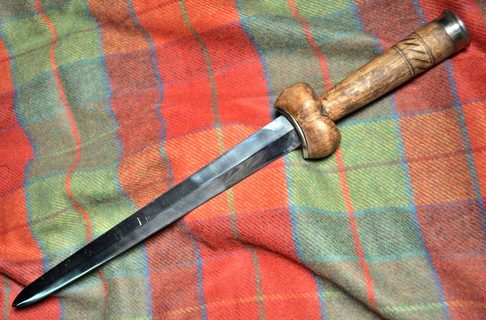
The dagger was, alongside the knife, a basic and usually the most accessible tool of self-defense in civilian life during the Middle Ages, as well as a fundamental part of offensive military equipment. The shapes of daggers varied throughout the medieval period depending on the development of armor, regional peculiarities, and fashion trends. Perhaps the longest-lasting and almost universal type of dagger was the so-called bollock dagger (German Nierendolch, French Dague à Couilletes, English Bollock dagger).
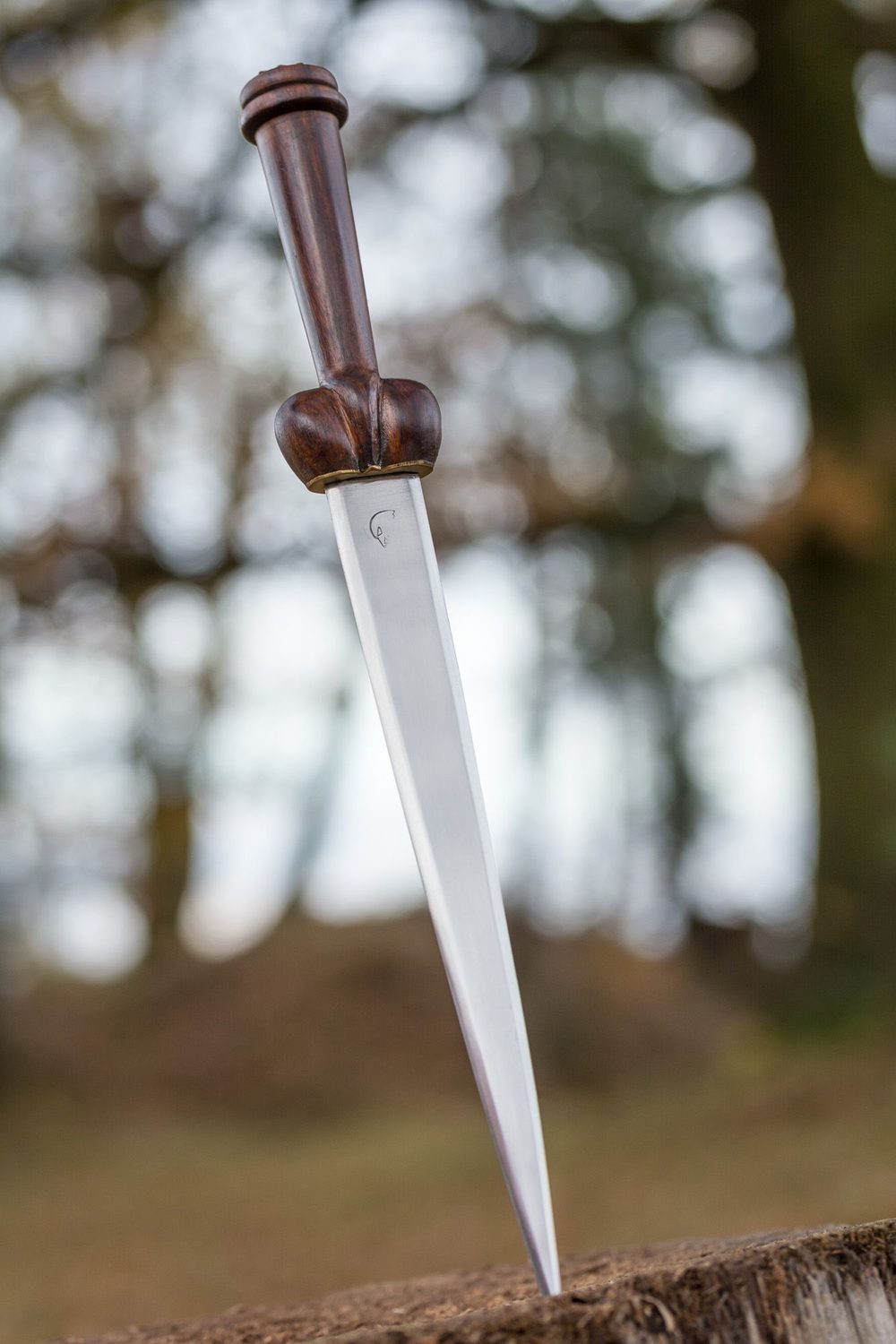
Behind this name lies a surprisingly simple weapon, with a smooth grip of circular or slightly oval cross-section that slightly widened and rounded towards the pommel. The pommel didn't always have to be hemispherical; it could also be slightly rounded and covered with a sheet of colored metal. Part of the grip, under the guard made of a metal plate or a thicker metallic segment with protrusions along the blade, consisted of two wooden spherical or ovoid shapes. This assembly, otherwise quite practical for gripping, evoked - whether intentionally or coincidentally - associations with male testes („bollock“), which led to the naming of this type of dagger. The more poetic term "kidney dagger," which was supposed to point out the similarity of the rounded shapes on the guard to kidneys, is a much younger creation of the repressed social morality of the late 19th century.
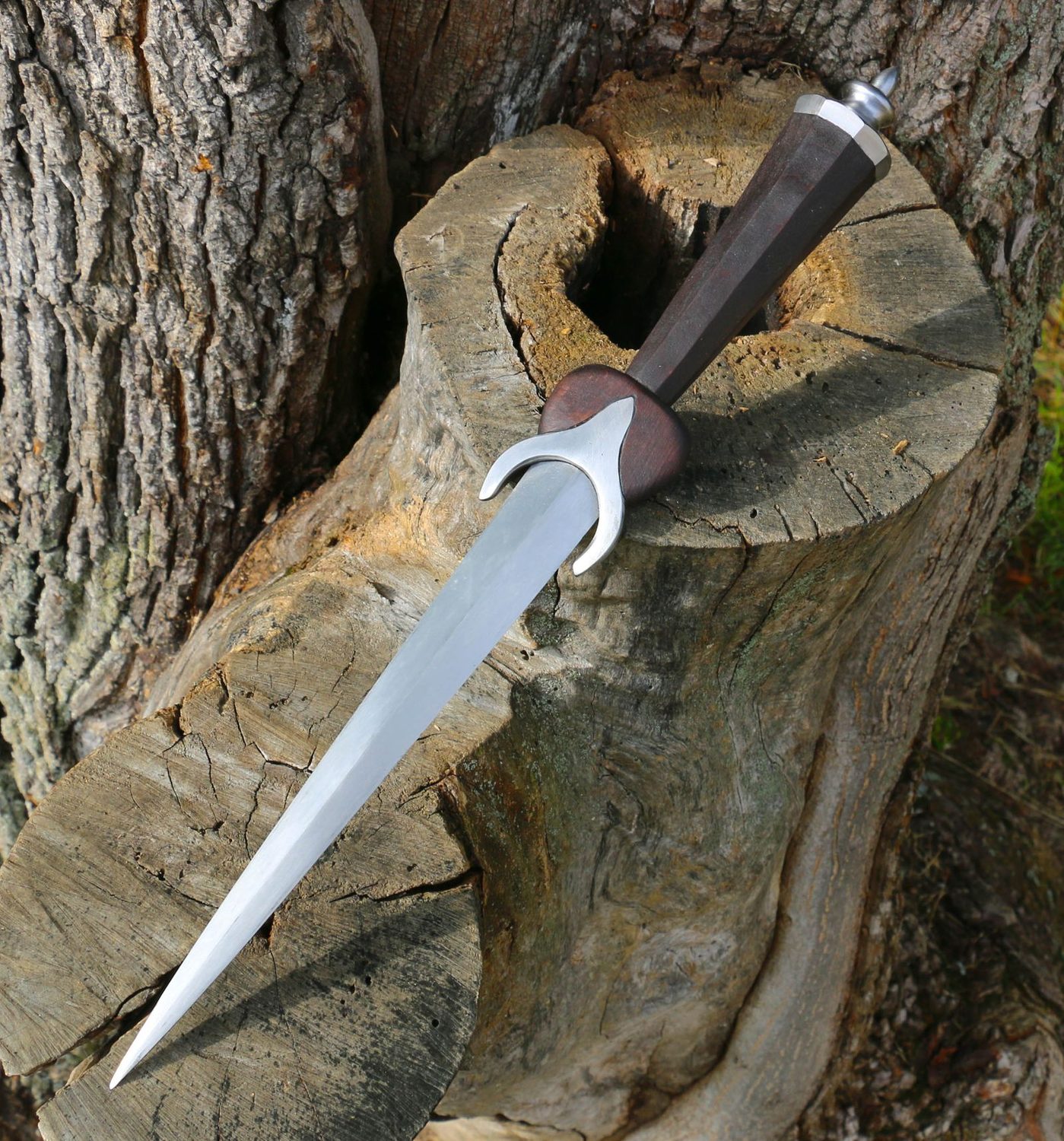
The blade of the dagger underwent several alternations over the centuries. It usually appeared either as a double-edged blade with a flattened rhomboidal cross-section. Another kind of blade with a triangular cross-section was sharpened on one side along its entire length and on the opposite side had the edge sharpened only perhaps up to ¼ to 1/3 of the blade length at the tip (but sometimes longer), as is the case with modern combat knives and daggers from the 20th and 21st centuries.
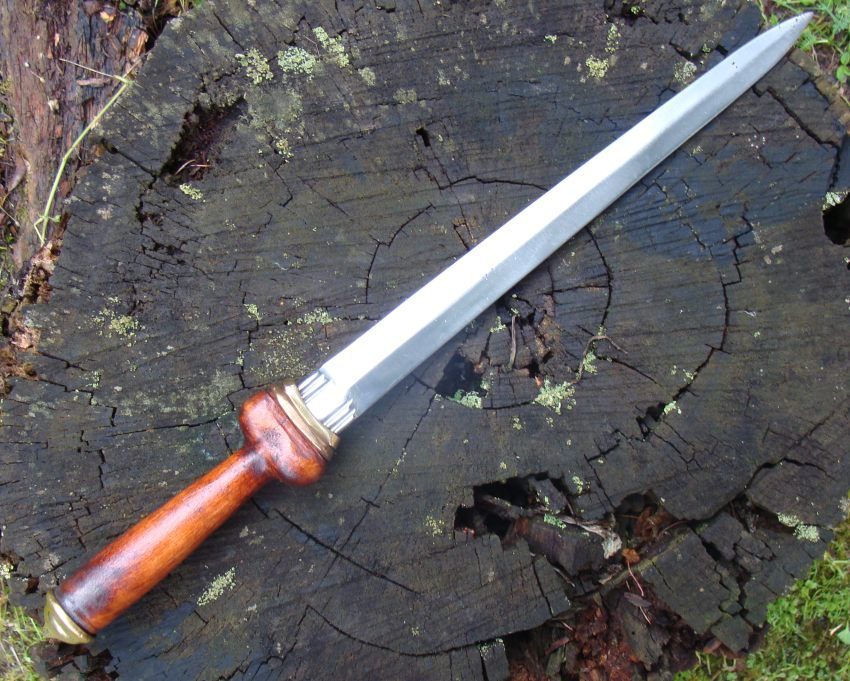
And did it say really "over the centuries" in a relation to the bollock dagger? Yes, of course - this type of dagger was indeed enduring. The oldest identified specimens are dated back to the late 13th and early 14th century, and from there onwards, the bollock dagger was widely used across Central and Western Europe until the mid-16th century. Archaeological finds and depictions confirm the presence of this type of dagger in the kingdom of Bohemia from around the second quarter of the 14th century, so it is evident that the aforementioned type of dagger served its purpose not only during the Luxembourg era but also during the Hussite wars and the post-hussite time periods of kings George of Poděbrady and Vladislaus Jagiello. Bollock daggers in various states of preservation have been found, for example, in Prague, Čáslav, Brno, and Hradišťko near Davle. Some of the uncovered specimens have well-preserved handles made of organic material, such as the dagger uncovered during excavations on Veselá Street in Brno. The wearing of bollock daggers persisted well beyond the mid-16th century until the 18th century in the Netherlands, Scandinavia, and the British Isles. With regard to visual and structural similarity, it is assumed that the Scottish dirk dagger evolved precisely from the so-called bollock daggers.
And what to read next?
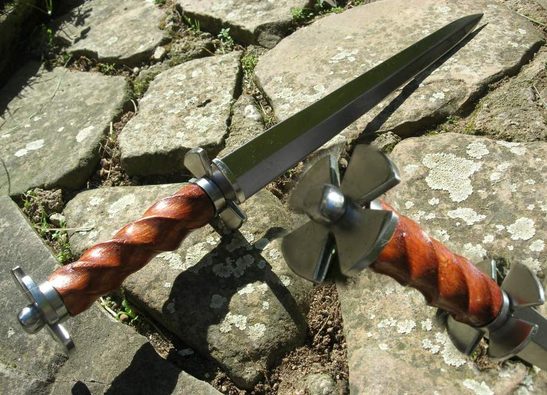
Rondel Dagger
When it comes to short sidearms of the late Middle Ages, it…

Kidney dagger – Bollock Dagger
The dagger was, alongside the knife, a basic and usually…

The Witcher
When Polish writer Andrzej Sapkowski finished the first…
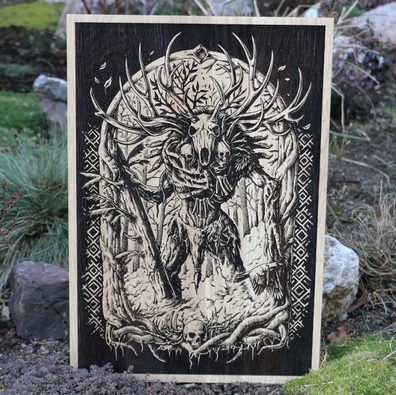
Leshy - Slavic forest spirit
Leshy - Slavic forest spirit


